.



A still image from a militant video posted on YouTube on April 3, 2015, shows a militant hammering a wall in Hatra, Iraq: image via Associated Press, 20 January 2016


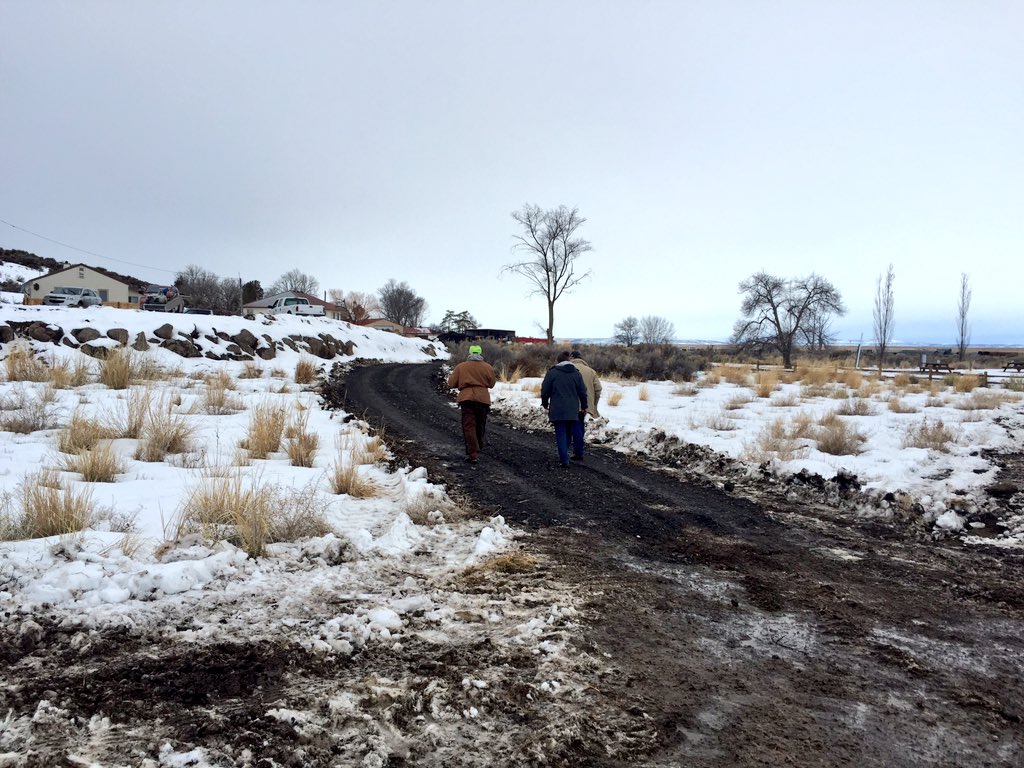
Today the #bundymilitia made this road within the refuge. #oregonstandoff: image via Amanda Peacher @amandapeacher, 14 January 2016
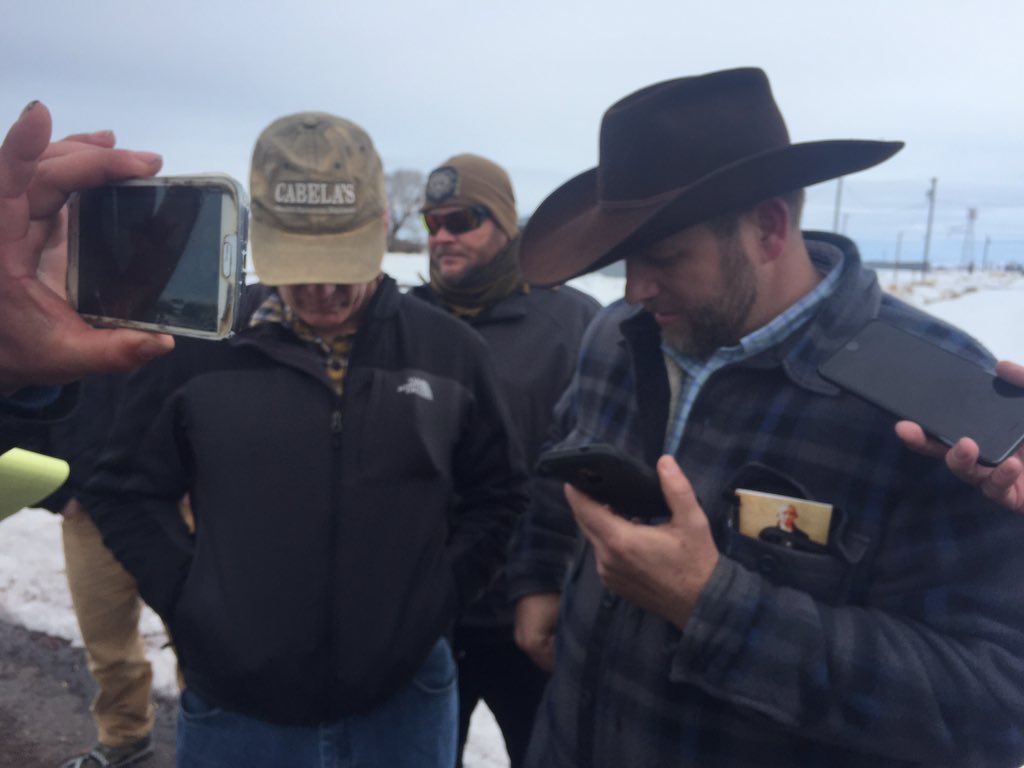
Bundy is talking with the FBI at Burns airport. #OregonStandoff: image via Amanda Peacher @amandapeacher, 21 January 2016
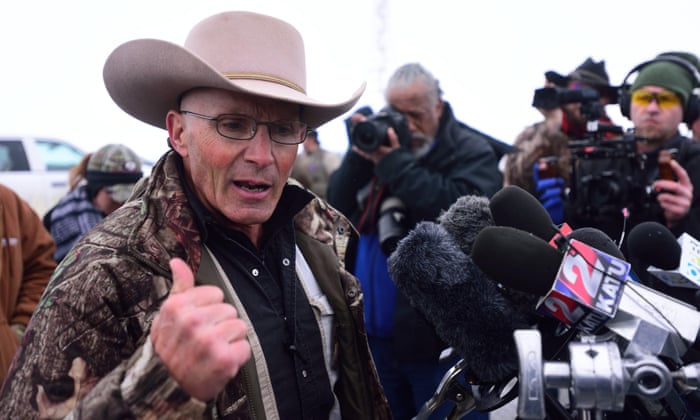
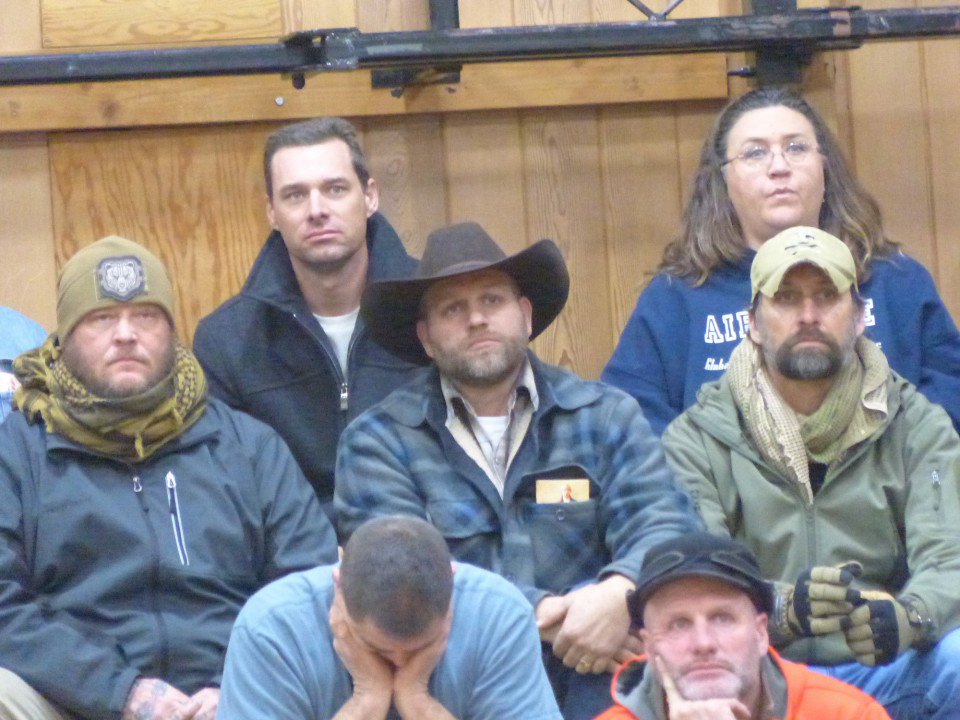
Ammon Bundy walks past wall of deputies into heated community meeting. Leaves in silence.: image via Les Zaitz @LesZaitz, 20 January 2016
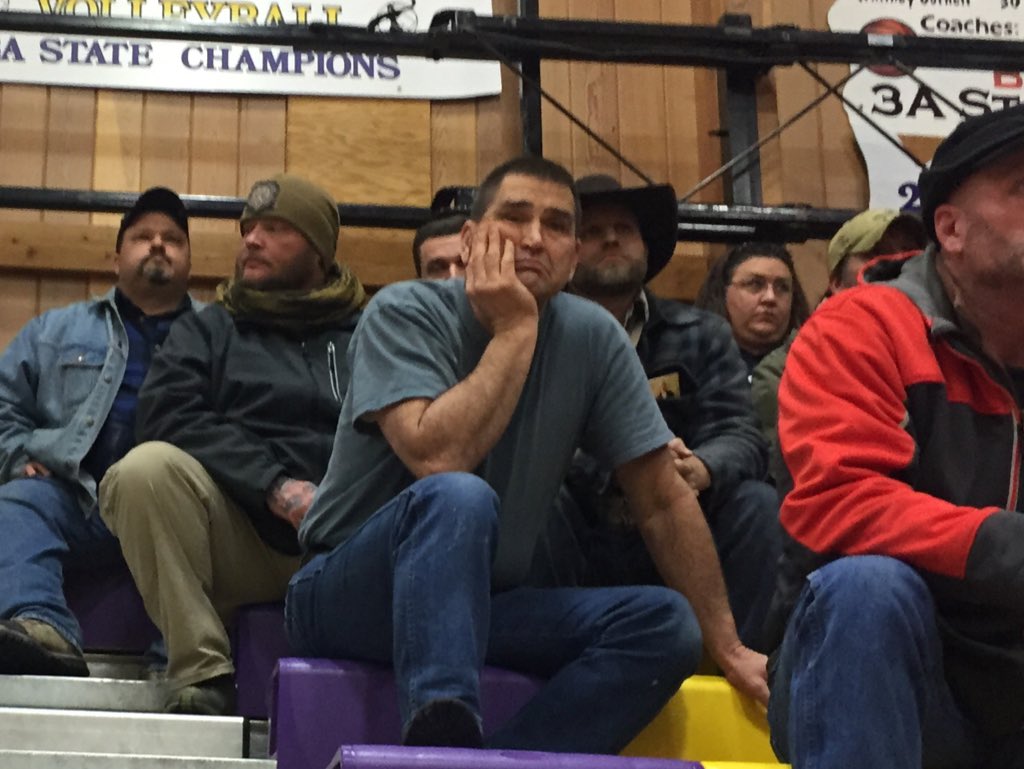
Bundy sits quietly. Oh, and "Fluffy Unicorn" is back: image via Amanda Peacher, 19 January 2016

The
armed occupiers at the Malheur National Wildlife Refuge want the
federal government to give back their land. This map of Oregon shows who
had that land in the first place. Note: No map of pre-conquest America
is exact because tribal "borders" were fluid: image via Daily Kos, 7 January 2016
Paiute tribal chair: 'Don't tell me any of these ranchers came across the Bering Strait': Meteor Blades, Daily Kos, 7 January 2016

Charlotte Rodrique, chairwoman of the Burns Paiute Tribe: photo via Daily Kos, 7 January 2016
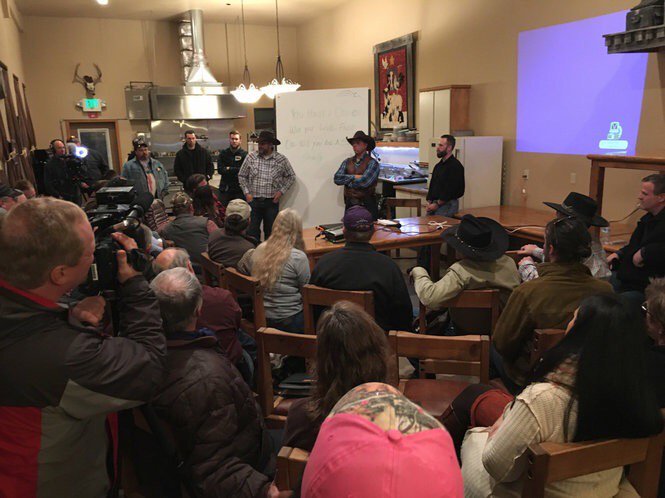
Oregon standoff leader warns feds: Back off.: image via Les Zaitz @LesZaitz, 20 January 2016
The Burns Paiute Reservation is located north of Burns, Oregon in Harney County. The current tribal members are primarily the descendants of the "Wadatika" band of Paiute Indians that roamed in central and southern Oregon.
Nine thousand years ago the northern Great Basin, which is now desert, was probably a series of very large lakes. The ancestors of the Burns Paiute people lived in caves near their shores. Horses, camels, mammoths, bison, elk and deer roamed the hills. These people used the fibers of the tule plant, willow, Indian hemp, and sagebrush bark to make woven sandals, coiled and twined baskets, and rope. They also made duck decoys, fish nets, and traps for small game with these fibrous plants. A beautiful soft blanket woven from the furs of rabbits and child's sandals made from sagebrush fibers were found preserved for close to 10,000 years in a cool, dry cave. Archeologists also found clothing made from deer, animal and bird hides. Their diet included a wide variety of items, such as fish (including a great deal of salmon), birds, deer, small animals, plants and seeds.
During the next one to 2,000 years, the climate slowly became drier and warmer. The lakes began drying up and food sources were less readily available. By 7,500 years ago, large mammals such as horses, camels and mammoth were extinct. People began seasonal migrations to take advantage of plants and animals in certain areas. Small family groups would travel separately collecting seeds, berries, roots, hunting small animals, deer, mountain sheep, elk and fish.
These smaller groups came together to harvest, socialize and intermarry with other Paiutes, as well as other Indian tribes. Spring offered roots to be gathered on the sunny hillsides and meadows, and fishing for salmon during the salmon runs. During the summer, berries and fruit were collected as food and stored for winter use. By late summer and early fall, seeds were the main resource to be gathered. Families also came together during this time of the year for communal antelope and rabbit drives. Late fall was the time to collect plant material to make items such as sandals, baskets, and clothing during the long winter months. By November, the families had gathered the cached goods they had put away during the months of harvesting. Materials were then gathered from the area (sagebrush in the desert or tules near the lakes) and they built houses near springs in which to live out the winter. The Paiutes lived in this manner for thousands of years.
The Paiute people believe that the Paiutes have lived in this area since before the Cascade Mountains were formed as they have learned from their stories and legends. Recent researchers, on the other hand, believe that about 1,000 years ago an influx of Paiute-speaking people came from the south and migrated throughout the Great Basin. They brought with them not only their language but also certain types of atlatl and spear points, and brownware pottery. Pottery was not found in the Great Basin before this time. However, the people of the Burns Paiute Tribe were basket makers and did not make pottery. According to the researchers, the language spoken here before the arrival of the Paiute is unknown. This, however, contradicts the Paiute stories and legends that are handed down from generation to generation which tell of the Paiute people living in the Great Basin for thousands and thousands of years.
The Burns Paiute Tribe descended from the Wadatika band, named after the wada seeds they collected near the shores of Malheur Lake to use as food. Bands were usually named after an important food source in their area. The Wadatika's territory included approximately 52,500 square miles between the Cascade Mountain Range in central Oregon and the Payette Valley north of Boise, Idaho, and from southern parts of the Blue Mountains near the headwaters of the Powder River north of John Day, to the desert south of Steens Mountain.
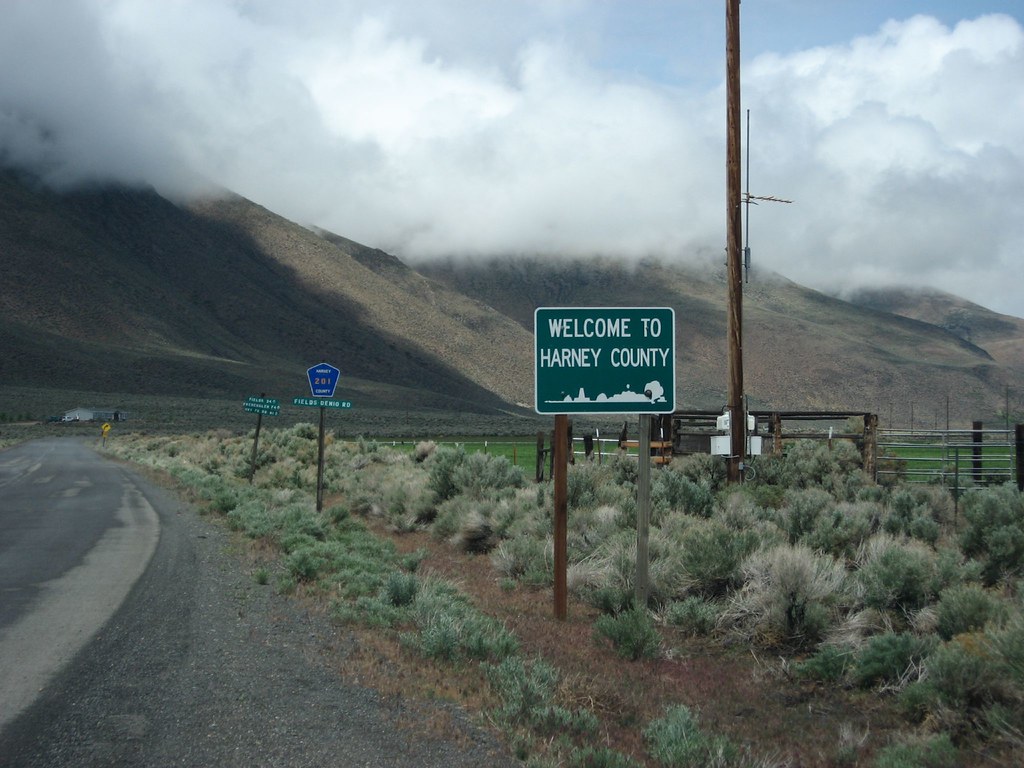
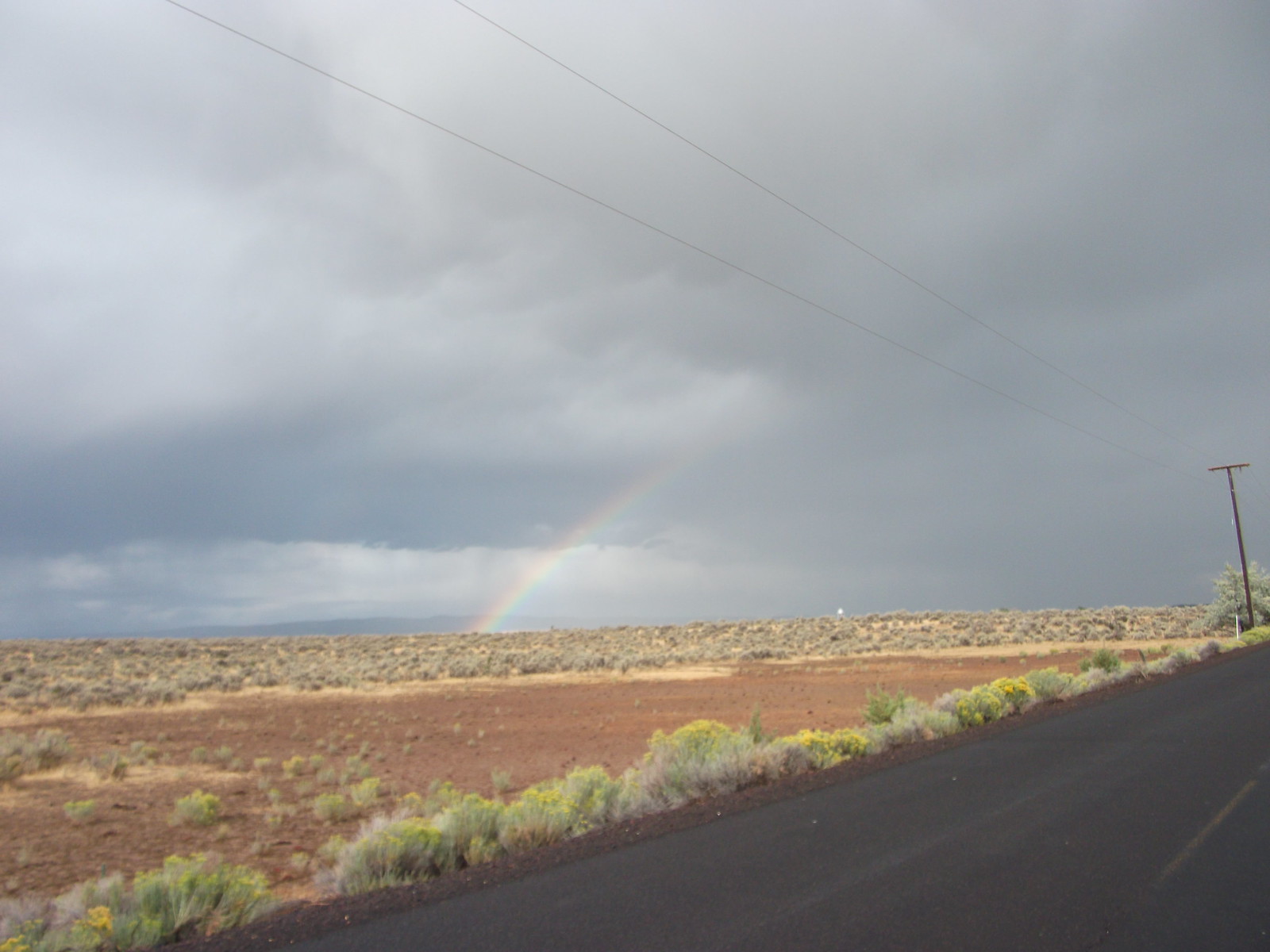
Rainbow near Burns: photo by Richard Bauer, 30 August 2014

Ryan Bundy talks on his mobile phone in
front of a large bulldozer at the Malheur National Wildlife Refuge
Headquarters in Burns, Oregon on January 6, 2016. A small group of armed
activists remained holed up at a remote US federal wildlife refuge in
Oregon, vowing to leave only if asked by local residents: photo by Rob Kerr / AFP, 6 January 2016
'Bundy Militia' Compared To ISIS For Pawing Through Native American Artifacts, Destroying Sites: Kristina Killgrove, Forbes, 21 January 2016
From the outset of the now weeks-long occupation of the Malheur
Wildlife Refuge in Oregon by the ‘Bundy militia,’ archaeologists as well
as members of the Burns Paiute Tribe have been concerned for ancient
artifacts and sacred spaces. Their fears were realized this week as news
reports discussed bulldozing of land and a video surfaced of armed
militants rifling through boxes of artifacts archived at the refuge. And
many on Twitter are already making a parallel between the militia and the work of ISIS in destroying world heritage sites.

In online statements and photographs, the Islamic State claimed to have smashed statues from the ancient Syrian city of Palmyra: photo by
Agence France-Presse, 3 July 2016
Indian
Country Today Media Network (ICTMN) has the best coverage thus far, in a
piece by Jacqueline Keeler titled, "Oregon Militia Nuts Hold Paiute
History, Artifacts Hostage.."
There are thousands of artifacts stored in the building that is being
occupied by the militia, and the Burns Paiute are worried. ICTMN reports
that “the tribe is demanding federal action under both the
Archeological Resources Protection Act of 1979 and a ‘protection against
bad men’ provision the tribe signed with the United States in 1868.”
This
is not the first time Bundy supporters have damaged or held Native
American heritage hostage. In 2014, half a dozen people rode ATVs
through Recapture Canyon in Utah,
destroying ancient Puebloan home sites. And petroglyphs in Gold Butte,
Nevada, may also have been defaced by Bundy supporters. Chairperson
Charlotte Rodrique of the Burns Paiute tribe told ICTMN that just a few
days ago “they took a bulldozer and built a line around the refuge
headquarters.”

A still image from a militant video posted on YouTube on April 3, 2015, shows a militant hammering a wall in Hatra, Iraq: image via Associated Press, 20 January 2016
The Bundy folks put out a 3-minute video showing themselves looking
through box upon box of Native American artifacts in the basement
archive of the refuge.
LaVoy Finicum and others talk repeatedly about how they want to
return the artifacts to “their rightful owners.”
They deplore the
conditions in which the artifacts are kept: “there’s a rat’s nest in
here; this is how we found them. [...] Native artifacts, they just kind
of boxed them up and let them rot here.”
Further, they complain that the
artifacts have different dates on them, some dating back to the 1980s.
Finicum looks at the camera and feigns concern: “So my question is, Why?
Why do they just keep them down here? Why are they locked away here
for nobody but for them to look at whenever they come down here. This
needs to be taken care of, and so we’re reaching out to the Paiute
people in as sincere a manner as we can. Please, let’s open up a
dialogue.”

A 13th-century tomb near Kirkuk in northern Iraq, destroyed by members of the Islamic State: photo by Ihsan Feti / Iraqi Architects Society, 3 July 2015
On the face of it, this doesn’t seem like a bad sentiment. For an
organization obsessed with individual rights, it makes sense in a way:
Finicum and others may actually be convinced that the Paiute objects
need rescuing. But their paternalistic concern for people they perceive
as downtrodden by the US government is misplaced. The Paiute agree that
the objects need to be rescued -- but rescued from Finicum and the other
militia members. Rodrique is further quoted in Daily Kos as saying that
“we feel strongly because we have had a good working relationship with
the Malheur National Wildlife Refuge” prior to the occupation. “We view
them as a protector of our cultural rights in that area.” The Paiute
helped archive the artifacts at the refuge in the first place.

Burns Paiute tribe chair Charlotte Rodrique
addresses reporters during a press conference in response to the armed
occupation of the nearby Malheur National Wildlife Refuge in Burns,
Ore., Wednesday, Jan. 6, 2016. A leader of the Oregon Indian tribe whose
ancestral property is being occupied by an armed group opposed to
federal land policy said Wednesday that the group is not welcome and
needs to leave.: photo by Manuel Valdes / AP, 6 January 2016
The
Daily Kos quotes tribal council member Jarvis Kennedy as saying, “They
just need to get the hell out of there. They didn’t
ask anybody, we don’t want them here.” And the archaeologist for the US
Fish and Wildlife Service, Carla Burnside, told ICTMN that militants
released photos of themselves in her office rifling through sensitive
archaeological files. Fish and Wildlife Service assistant director of
external affairs, Jason Holm, further told Oregon Public Broadcasting
that the road the occupiers recently bulldozed is “an archaeological
site important to the Burns Paiute Tribe.” They also removed a fence
that Holm said was “a deterrent to keep fire crews from driving across
the archaeological site.”

Today the #bundymilitia made this road within the refuge. #oregonstandoff: image via Amanda Peacher @amandapeacher, 14 January 2016
The actions of the ‘Bundy militia’ almost certainly go against ARPA,
in spite of what Finicum and friends seem to think. Legal protections
have been put into place over decades in the US to protect Native sites,
artifacts, and burials and to help right the wrongs done to Native
archaeological remains since Europeans first landed. Finicum may think
he is doing the right thing in his misguided attempt to repatriate
artifacts that are being stored at the refuge by choice and by design,
but the Paiute vehemently disagree. And as it’s their heritage, it’s
their right to rebuff Finicum and to bring federal action against the
occupants who have no idea how to handle the artifacts or how to
safeguard their sacred sites.
Rodrique’s quote in ICTMN sums it up for me, and for many of the
people in my Twitter feed outraged by this brash disregard for the
opinions of Natives: “I don’t know what these people are doing… if they
are doing things to just get a rise or to be a martyr -- all they are
doing is making enemies out of the people they professed to support.”
Kristina Killgrove is a bioarcheologist at the University of West Florida

Bundy is talking with the FBI at Burns airport. #OregonStandoff: image via Amanda Peacher @amandapeacher, 21 January 2016
Looting the artifacts and documents
Charlotte Rodrique, tribal chair: "We pray for the winged animals...this
group of naughty ppl is down there w/no respect for the land." #OregonStandoff: tweet via Amanda Peacher@amandapeacher, 21 January 2016

LaVoy Finicum posted a video
of himself inside a government building looking through cardboard boxes
of papers and other items associated with the Paiute tribe. The militiamen stationed at a federal wildlife refuge in eastern
Oregon are now rummaging through artifacts and documents of the Paiute
tribe, sparking outrage among local Native Americanswhose ancestors originally occupied the land.: photo by Rex/Shutterstock via The Guardian, 21 January 2016
Fresh
outrage after militia seen rifling through tribal artifacts at Oregon
refuge: Standoff leader posted a video of him looking through artifacts
and
documents from the Paiute tribe at the Malheur national wildlife refuge,
sparking outrage: Sam Levin, The Guardian, 21 January 2016
The militiamen stationed at a federal wildlife refuge in eastern
Oregon are now rummaging through artifacts and documents of the Paiute
tribe, sparking outrage among local Native Americans whose ancestors originally occupied the land.
LaVoy Finicum, one of the leaders of the armed protesters occupying the Malheur national wildlife refuge, posted a video
of himself inside a government building looking through cardboard boxes
of papers and other items associated with the local tribe –- and
inviting Paiute leaders to meet with the militia and reclaim their
belongings.
“We want to make sure these things are returned to their rightful
owner,” said Finicum, who recently helped destroy a US Fish and Wildlife
Service fence and remove cameras that he claimed the government was
using for surveillance.
The rightwing militia, led by Ammon Bundy, took over the headquarters of the wildlife sanctuary
on 2 January to protest the government’s land-use regulations in rural
Harney County. They have demanded that local ranchers have control of
public lands –- not the federal government.
But days after the occupation began, leaders of the federally
recognized Paiute Indian tribe in Burns, the town closest to the refuge, decried the armed occupation,
pointing out that the out-of-state militiamen were trying to claim
sacred lands that are part of the tribe’s ancestral territory.
The new video, posted on Wednesday night, has only further enraged
tribal leaders who recently called on law enforcement officials to
protect native cultural resources at the refuge and to criminally
prosecute the militiamen.
“I feel disrespected that they’re even out there,” said Jarvis
Kennedy, the tribal council’s sergeant-at-arms. Kennedy said he was too
upset to watch all of Finicum’s video. “It’s like me going through their
drawers at their house.”
Tribe leaders and federal officials
say the refuge stores confidential documents and thousands of historic
artifacts, such as baskets, spears, tools and beads. The refuge is also
home to Paiute burial grounds, making the militia’s recent decision to pave a road through the refuge particularly alarming.
“I could go to the Bundys where his grandparents are buried,” Kennedy
said. “How would they feel if I drove over their grave and went through
their heirlooms?”
In his video, Finicum said that he was showing how the wildlife
refuge has done a poor job maintaining the artifacts and keeping storage
rooms clean. “This needs to be taken care of, and so we’re reaching out
to the Paiute people in the sincerest manner as we can,” he said on
camera. “Let’s make sure that we take care of the heritage of the Native
American people.”
Added militia member Blaine Cooper: “The rightful owners need to come back and claim their belongings.”
But Kennedy said the tribe has a good relationship with refuge
officials and noted that the Paiute people refuse to communicate with
militia leaders or visit the occupation.
“I’m not going to give them the satisfaction of meeting with them,”
Charlotte Rodrique, chairwoman of the Burns Paiute tribe, told the
Guardian last week.
Kennedy noted that the militiamen have had no trouble leaving and returning to the refuge
and feared one of them might damage or steal their artifacts and
documents. “All the stuff they are doing out there, it’s like a crime
scene,” he said. “Once this is done, we’ll see what’s missing.”

Ammon Bundy walks past wall of deputies into heated community meeting. Leaves in silence.: image via Les Zaitz @LesZaitz, 20 January 2016
4,000 artifacts stored at Oregon refuge held by armed group: Rebecca Boone, AP, 15 January 2016
Thousands
of archaeological artifacts -- and maps detailing where more can be
found -- are kept inside the national wildlife refuge buildings currently
being held by an armed group of protestors angry over federal land
policy.
Ryan Bundy, one of the leaders of the group occupying the Malheur
National Wildlife Refuge in southeastern Oregon, says they have no real
interest in the antiquities. Still, their access to the artifacts and
maps has some worried that looters could take advantage of the
situation.
"There's a huge market for artifacts, especially artifacts that have
provenance, where you can identify where they came from," said Carla
Burnside, the U.S. Fish and Wildlife Service's refuge archeologist.
More than 300 recorded prehistoric sites are scattered across the
refuge, including burial grounds, ancient villages and petroglyphs. Some
of the artifacts -- including spears, stone tools, woven baskets and
beads -- date back 9,800 years.
The artifacts and remains came from ancestors of the Burns Paiute
Tribe. Chairwoman Charlotte Rodrique says she feels helpless knowing
that her tribe's cultural heritage is now in the hands of the armed
group.
"As far as I'm concerned, our history is just another hostage," Rodrique said.
The tribe has sent a letter to the U.S. Fish and Wildlife Service and
the U.S. attorney for Oregon, Billy Williams, asking that members of
the armed group be prosecuted if any artifacts or maps are damaged or
missing.
__
WHY AREN'T THE RELICS AT A MUSEUM?
About 7,000 artifacts and samples from the refuge are kept at a
museum in Eugene, Oregon. But 4,000 more are kept at the refuge for
research.
Only Burnside has a key to the room containing the artifacts and the
maps. She's since seen pictures of the occupiers in her office, adjacent
to the room where the artifacts are stored. The group has been looking
through government files at the site, but it is unclear if they've gone
through the room with the artifacts. Bundy told The Associated Press
that he's seen the artifacts and lots of maps, but he didn't know what
the maps illustrated.
The artifacts and maps are legally protected by the 1979 Archeological Resources Protection Act and other federal laws.
Rodrique said she doesn't know if members of the group have disturbed
the artifacts but wants the artifacts and documents catalogued as the
occupation continues and once it comes to an end.
"If the occupiers disturb, damage, remove, alter or deface any
archaeological resource on the refuge property, the Tribe requests that
the United States bring criminal charges," Rodrique wrote in her letter
to federal officials.
___
WHAT IS THE ARMED GROUP DOING WITH THE ARTIFACTS?
Bundy said they're not interested in the artifacts and would turn them over to the Burns Paiute Tribe, if asked.
"If the Native Americans want those, then we'd be delighted to give them to them," he said.
Rodrique said the tribe is not going to legitimize the armed group's occupation of the refuge by negotiating with them.
"That's our history, our ancestors' possessions and remains,"
Rodrique said. "It's hard to explain, as a native person, what that
means to us. That's the very proof of our existence in this country."
Bundy said he didn't think it was likely that anyone would use the maps to loot the site.
"We haven't really been thinking along those lines," Bundy said.
Removing artifacts from federal property without a permit is illegal.
___
WHAT ABOUT THE PREHISTORIC SITES?
Scientists are also worried about unintentional damage that could be
done to the prehistoric sites by cattle, vehicles and heavy equipment.
The group at the ranch has driven road graders and other large
construction equipment around the refuge headquarters buildings, but
Bundy said Thursday they haven't used the machinery to move any earth.
He wouldn't rule out that possibility, however.
In 2014, Ryan Bundy and supporters of the Bundy family rode ATVs on
federal land closed to motorized vehicles in Utah as part of a protest.
Their route took them along an illegal trail that crossed through Native
American archeological sites.
___
HAVE THE SITES BEEN LOOTED BEFORE?
While well-known petroglyphs or other prehistoric sites are
occasionally publicized for public viewing, federal land managers often
go to great lengths to keep such locations secret when they can't be
safely protected from vandals and looters.
Looting has long been a problem at the refuge, with the first
documented instance recorded in 1979, according to the Fish and Wildlife
Service's comprehensive conservation plan.
"It's a huge problem in Oregon, especially in the southeast portion
of the state," said Dennis Griffin, the state's archaeologist. "More
often than not, when they are caught, it's connected to drug running or
seeking quick money on eBay."
An online search of "great basin artifacts for sale" yields
arrowheads, stone pestles and other items, many priced at hundreds of
dollars each.
___
WHY DOES IT MATTER?
Burnside said the artifacts are part of the ancestry of the Burns Paiute Tribe and are priceless to science.
"There's so much you can gain from looking at one artifact: Where the
stone came from, how far they traveled, how it was used, the skill of
the person who made it," she said.
The tribe works extensively with federal officials on the archeology
projects. In her letter, Rodrique said the tribe knows it's a difficult
time for Burnside and other refuge employees, and thanked the U.S. Fish
and Wildlife Service for its cooperation and help.
"All I want is that our past be respected, that things don't go by
the wayside, that they're not destroyed by cattle," Rodrique said in a
phone interview.
"Their history is being hijacked by these people," said Donald
Grayson, an anthropologist and archeology expert at the University of
Washington.
___
HOW DOES BUNDY WANT THE ARCHEOLOGICAL SITES HANDLED?
Bundy said people interested in archeology are welcome to explore the
refuge, but that cattle ranchers and loggers should have priority when
it comes to land use.
"Before white man came, so to speak, there was nothing to keep cattle from tromping on those things," Bundy said.
Though some countries had domesticated cattle 10,000 years ago, the animals came to the United States with European settlers.
"We also recognize that the Native Americans had the claim to the
land, but they lost that claim," Bundy said. "There are things to learn
from cultures of the past, but the current culture is the most
important.""

Bundy sits quietly. Oh, and "Fluffy Unicorn" is back: image via Amanda Peacher, 19 January 2016

Paiute tribal chair: 'Don't tell me any of these ranchers came across the Bering Strait': Meteor Blades, Daily Kos, 7 January 2016
As the media continue spotlighting the armed extremists occupying
the federal headquarters of the Malheur National Wildlife Refuge in
Oregon, their complaints about federal government “over-reach,” and
their demands that the feds “give the land back,” members of another
group say that if there were to be any giveback, they ought to be first in line.

Charlotte Rodrique, chairwoman of the Burns Paiute Tribe: photo via Daily Kos, 7 January 2016
They are the Burns Paiute Tribe, descendants of the people the U.S.
Army under Gen. George Crook starved and murdered into submission in the
1860s in a successful effort to confine them to a 1.8 million-acre
reservation. This was later reduced to the 1,000 or so acres where the
420-member tribe is now headquartered. The Paiute leaders are
profoundly irked by the occupiers’ demands. Amanda Peacher reports:
“Armed protesters don’t belong here. By their actions, they are endangering one of our sacred sites,” said tribal Chair Charlotte Rodrique.
Rodrique said she told a friend she was offended by the militants’ notion that they could return the refuge lands to their rightful owners.
“I’m sitting here trying to write an acceptance letter for when they return all this land to us,” Rodrique said.
For all too many American Indians, it’s a familiar story.
Chairwoman Rodrique also said, “Don't tell me any of these ranchers came across the Bering Strait and settled here."
The archeological record shows that people populated the land now
surrounding the 190,000-acre Malheur preserve at least 6,000 years ago.
The Northern Paiute were there at least back as far as 1,300 years ago.
As land-hungry white settlers started flooding into the area in the
late 1850s, the Paiutes objected forcefully. That brought calls for the
Army to step in and quell resistance. Immediately after the Civil War,
it did just that. After nearly half the tribe had been wiped out by
starvation and slaughter for defending themselves, Crook’s dictum was
“peace or death.” Outnumbered and outgunned, the Paiutes gave in.
In 1868, a treaty was “negotiated” at gunpoint with the Paiutes and
other tribes in eastern Oregon. The government promised to prosecute any
whites who killed or injured Indians. But the Senate refused to ratify
the treaty. This was a common occurrence. Tribes would sign treaties and
make land concessions and the government negotiators would agree to
certain obligations. But, not unusually, the Senate would either not
ratify the treaty or would make deep changes in it, such as reducing
annuities, often without informing the tribe. However, the
treaty-signing tribe was required to stick to its side of the
agreement.
As another tribe’s leader -- the Oglala Lakota chief Red Cloud (Mahpiua Luta) -- would later say: “They made us many promises, more than I can remember, but they kept one; they promised to take our land, and they did."
In 1872, by executive order, President U.S. Grant established the
Malheur Reservation. But almost immediately white settlers poured in,
and then prospectors found a little gold. Rather than enforce the
executive order, the government gave cover to the settlers and gold
diggers by opening the boundaries of the reservation. Clashes were
inevitable.
Topping that off, as was so often the case elsewhere, the private
contractor Washington installed as the government’s agent for the
Paiutes was an Indian hater who withheld food and other allotments the
tribe was supposed to receive.
In 1876, in response to this encroachment on the reservation
lands his people had been guaranteed, Paiute Chief E-He-Gant (Egan) fumed:
"Did the government tell you to come here and drive us off this reservation? Did the Big Father say, go and kill us all off, so you can have our land? Did he tell you to pull our children's ears off, and put handcuffs on them, and carry a pistol to shoot us with? We want to know how the government came by this land. Is the government mightier than our Spirit-Father, or is he our Spirit-Father? Oh, what have we done that he is to take all from us that he has given us? His white children have come and taken all our mountains, and all our valleys, and all our rivers; and now, because he has given us this little place without our asking him for it, he sends you here to tell us to go away. Do you see that high mountain away off there? There is nothing but rocks there. Is that where the Big Father wants me to go? If you scattered your seed and it should fall there, it would not grow, for it is all rocks there."
That wasn’t the end. The Paiutes joined the Bannocks in 1878 and
renewed their resistance to encroachment. A brave but hopeless
fight. Ultimately, all the Northern Paiutes were moved off the
reservation and shipped to Fort Simcoe in Washington state. In the
early 1880s, the now-vacated Malheur Reservation was completely opened
to homesteaders and miners. Eventually, under the Dawes Act of 1887 that
squeezed two-thirds of their remaining land out of Indian hands across
the West, just 115 Paiutes were given private allotments of 160 acres
each. Most of these were sold off to non-Indians over the years. About
25 of those allotments remain in Paiute hands today.
As noted, this story of theft and murder, of “peace or death,” is not
extraordinary. It’s the story of America. One which ranchers, miners
and irrigators, including the gunslinging thugs of the Bundy Bunch,
still benefit from today.

Oregon standoff leader warns feds: Back off.: image via Les Zaitz @LesZaitz, 20 January 2016
History and Cultural Background of the Burns Paiute Tribe
"Paiute Wadatika Ma-Ni-Pu-Neen"
The Burns Paiute Reservation is located north of Burns, Oregon in Harney County. The current tribal members are primarily the descendants of the "Wadatika" band of Paiute Indians that roamed in central and southern Oregon.
Nine thousand years ago the northern Great Basin, which is now desert, was probably a series of very large lakes. The ancestors of the Burns Paiute people lived in caves near their shores. Horses, camels, mammoths, bison, elk and deer roamed the hills. These people used the fibers of the tule plant, willow, Indian hemp, and sagebrush bark to make woven sandals, coiled and twined baskets, and rope. They also made duck decoys, fish nets, and traps for small game with these fibrous plants. A beautiful soft blanket woven from the furs of rabbits and child's sandals made from sagebrush fibers were found preserved for close to 10,000 years in a cool, dry cave. Archeologists also found clothing made from deer, animal and bird hides. Their diet included a wide variety of items, such as fish (including a great deal of salmon), birds, deer, small animals, plants and seeds.
During the next one to 2,000 years, the climate slowly became drier and warmer. The lakes began drying up and food sources were less readily available. By 7,500 years ago, large mammals such as horses, camels and mammoth were extinct. People began seasonal migrations to take advantage of plants and animals in certain areas. Small family groups would travel separately collecting seeds, berries, roots, hunting small animals, deer, mountain sheep, elk and fish.
These smaller groups came together to harvest, socialize and intermarry with other Paiutes, as well as other Indian tribes. Spring offered roots to be gathered on the sunny hillsides and meadows, and fishing for salmon during the salmon runs. During the summer, berries and fruit were collected as food and stored for winter use. By late summer and early fall, seeds were the main resource to be gathered. Families also came together during this time of the year for communal antelope and rabbit drives. Late fall was the time to collect plant material to make items such as sandals, baskets, and clothing during the long winter months. By November, the families had gathered the cached goods they had put away during the months of harvesting. Materials were then gathered from the area (sagebrush in the desert or tules near the lakes) and they built houses near springs in which to live out the winter. The Paiutes lived in this manner for thousands of years.
The Paiute people believe that the Paiutes have lived in this area since before the Cascade Mountains were formed as they have learned from their stories and legends. Recent researchers, on the other hand, believe that about 1,000 years ago an influx of Paiute-speaking people came from the south and migrated throughout the Great Basin. They brought with them not only their language but also certain types of atlatl and spear points, and brownware pottery. Pottery was not found in the Great Basin before this time. However, the people of the Burns Paiute Tribe were basket makers and did not make pottery. According to the researchers, the language spoken here before the arrival of the Paiute is unknown. This, however, contradicts the Paiute stories and legends that are handed down from generation to generation which tell of the Paiute people living in the Great Basin for thousands and thousands of years.
The Burns Paiute Tribe descended from the Wadatika band, named after the wada seeds they collected near the shores of Malheur Lake to use as food. Bands were usually named after an important food source in their area. The Wadatika's territory included approximately 52,500 square miles between the Cascade Mountain Range in central Oregon and the Payette Valley north of Boise, Idaho, and from southern parts of the Blue Mountains near the headwaters of the Powder River north of John Day, to the desert south of Steens Mountain.
-- via The Burns Paiute Tribe, 17 March 2014

Welcome to Harney County, Oregon: photo by Ken Lund, 26 May 2008

Rainbow near Burns: photo by Richard Bauer, 30 August 2014




10 comments:
Jan 20 NATIVE AMERICAN ARTIFACTS
... Right. And so, you run into these guys in the video on a country road in the middle of nowhere. And they say, Just trust us, we're going to come over and guard your artifacts...
This story just becomes more and more outrageous. I will share your post with some of my former colleagues at the Natl Museum of the American Indian. Thanks, Tom.
Tom,
Great background material here (history of the Paiute people on this land) and also what's going on in the foreground (Citizen Finicum seeming to mean so well -- who does he think he's fooling anyway) . . . meanwhile, the sagebrush saga continues . . .
Terry and Steve, big thanks for the encouragement to think others are equally agape, at this point, over these doings.
It's finally (of course) impossible to stay out of the way of any story while attempting to report it... and this is becoming a story with a very strange shape to it... strange, that is, until the relation of each successive episode in the saga to the larger story of the deterioration of the "body politic" begins to dawn... take for example yesterday's surreal FBI/Peckerwood Gang "conference" call, almost as strange, if nothing like so scary, as the sheer horror-movie experience of spending three and a half minutes (eternity) trapped inside the violated Paiute archive storage area with LaVoy Finicum, his free-radical eyeballs and his helpful pinhead video crew...
A small but (I thought) telling point noted by just one of the reporters dutifully shivering on the frigid high desert tarmac while eavesdropping as Ammon Bundy and a friendly FBI spokesperson, seemingly yclept "Chris", conducted their equable one-hour chat on speakerphone -- from his side of the conversation it's indicated that prior to his attendance at this charming little Showdown-That-Wasn't, Bundy had wagered with one or more of his fellow Mormon terrorists that the FBI outreach guy was "one of us"... (see Amanda Peacher tweet below).
Amanda Peacher @amandapeacher 5h5 hours ago:
Interestingly, there was not a swarm of armed officers there. Just three FBI agents in ball caps and a few deputies. #Oregonstandoff
Amanda Peacher @amandapeacher 5h5 hours ago:
At the end of the convo, Ammon asked FBI negotiator if he's LDS. Negotiator said no. "I lost a bet," said Bundy.
But I don't expect anybody will have heard much if anything about that cozy little tarmac chat, so here's a bit of detail from a local news source (reporter also evidently a rancher by the way):
BURNS – Ammon Bundy, standing in a biting, freezing wind Thursday at the police blockade to the local airport, borrowed a cellphone from an FBI agent.
On the other end was an FBI negotiator who identified himself to Bundy only as "Chris."
And so opened talks between the leader of the refuge occupation and the federal agency in charge of bringing an end to the armed takeover, now in its third week.
For nearly an hour around noontime, the negotiator listened to Bundy's well-practiced litany of complaints against the federal government while probing for what it would take to end his occupation of the Malheur National Wildlife Refuge.
They ended the call with the promise to talk again Friday.
Bundy and Ryan Payne, another takeover organizer, said the FBI reached out by phone and by messenger starting two days ago.
Bundy said he had 14 voice messages Wednesday from the negotiator – the same day that Gov. Kate Brown publicly scolded federal officials for what she said was their slow approach to ending the Harney County standoff.
Bundy showed up unannounced at the Burns Municipal Airport, which is serving as an operations base for the FBI. He said he was there to talk with Chris but was told that the negotiator wasn't there, though they could talk by phone.
Bundy stood on the pavement of the driveway to the airport as he talked, a bodyguard beside him, with two plainclothes FBI agents as well as armed FBI agents in tactical dress standing nearby.
He put the cellphone on speaker, allowing all to listen in on the first known conversation between the federal agents and Bundy since the occupation started Jan. 2.
"I'm a face-to-face kind of guy," Bundy told the negotiator. "You reached out to me ... I'm not sure exactly what you wanted to talk about."
[tarmac chat continued:]
The conversation sounded in some ways like acquaintances catching up, with the FBI negotiator asking about activities out at the refuge...
The negotiator asked why Bundy picked Harney County.
"You're familiar with the Hammonds," Bundy said in a sardonic tone...
The negotiator pressed for what Bundy wanted to see done with the refuge. Bundy said it should be turned over to Harney County officials.
He said his group wouldn't leave until practical steps had been taken to get the refuge out of federal control and ensure the refuge buildings were never again used by the federal government.
How would that get done, the agent asked.
"I don't know," Bundy said. "We could put more thought to that."...
Bundy had questions of his own. He asked by what right was the FBI involved in the refuge occupation.
"Are you here under authority of the sheriff?" Bundy asked.
When the negotiator said the sheriff had asked for federal help, Bundy responded, "You do not have the people's authority to be here."
In measured tones, the negotiator told him, "The sheriff has asked for our assistance."
Sheriff Dave Ward has repeatedly told the occupiers to go home and met with Bundy two weeks ago, promising him safe passage out of the county. But the sheriff said Bundy wouldn't take him up on the offer.
As the negotiator repeatedly cycled back to the issue of how to end the standoff, Bundy was equally insistent that action had to happen – not just talk.
One action was paramount to ending the standoff, he said: "You can bring the Hammonds back home..."
When the negotiator asked if he was referring to a presidential pardon, Bundy had a quick response. "The president didn't put them" in prison, Bundy said. "You and I both know the president is not going to get them out."
Instead, he said the federal prosecutors who put the Hammonds in prison "need to work their magic" to free the ranchers.
Bundy brought the conversation to a close, saying he had other meetings and tasks to attend. A group of New Mexico state legislators was expected at the refuge, he said.
The negotiator asked how they could stay in touch, whether he could use a landline at the refuge to reach Bundy. Bundy demurred, saying the occupiers weren't using refuge phones.
"We want to work together with you," the negotiator said.
The two agreed to connect again in 24 hours.
With that, the negotiator hung up, Bundy handed the borrowed cellphone to an FBI agent and headed to a pickup truck for the 30-mile drive back to the refuge.
Les Zaitz, The Oregonian, 21 January 2016
Tom,
Maybe instead of taking any "practical steps" someone should just whack these wackos with a fly swatter and be done with it.
Seems like they want to finish the earlier job of ethnic cleansing.
After three weeks of what after all must be admitted to be a limited life span evaporated into thin air in the migrainoid close monitoring of the slippy surface of the surreal soap bubble inside which this desert basin of a murican story has sprouted its petrified forest of aporia, I can't help feeling overcome by an intense need to escape. That must be the patriotism surging up again.
About the racism of the constitutional thug army, I believe the central faux-cowboy not-really-rancher Mormon cadre practises the standard generic offhand/nonchalant diluted murican brand of it, whereas the skinhead tattoo faction, perhaps a bit, nay even more than a bit more aggressive, but hey, it's a free country, right, for anybody who's packing a big enough weapon.
Post a Comment